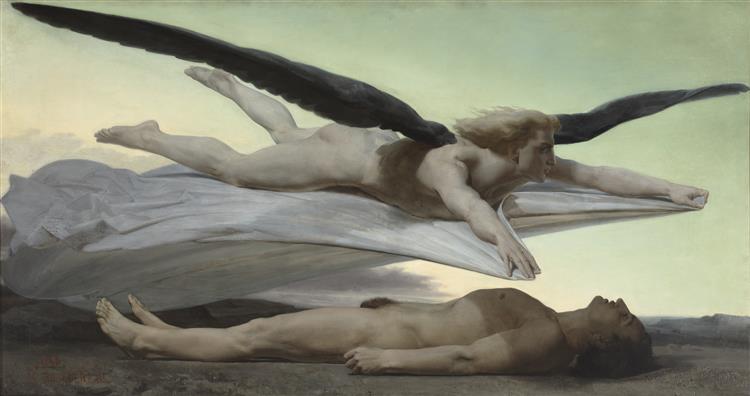Tanım
William-Adolphe Bouguereau's Equality in the Face of Death, created in 1848, emerges as a powerful artistic and philosophical statement. In this painting, Bouguereau, a master of French Realism and Academicism, employs his signature meticulous and emotive style to explore the theme of mortality and its inevitability, as well as the primal equity that death signifies for all humanity, regardless of social status or differences in life.
At first glance, the composition is striking in its drama and emotional charge. The work features two bodies, one male and one female, arranged in the centre, surrounded by a background that blurs any temporal or geographical context, allowing the viewer to concentrate on the intimate interaction of the characters. The male figure lies dead, his face reflecting an unusual serenity, while the female figure, who could be interpreted as the personification of life or a loved one, leans over him with a gesture of compassion and sadness. Bouguereau captures this scene with a precision and vibrant detail that are hallmarks of his work, creating a visceral connection with the viewer.
The palette used is rich and varied, with colours ranging from soft skin tones to deep shades of blues and greens that form the hazy background. Bouguereau's mastery of colour is evident in the way they complement and contrast each other, highlighting the characters' emotions through light and shadow. The lighting seems to come from an imaginary source, accentuating the three-dimensionality of the figures and lending an almost ethereal air to the scene.
The bodies, characterized by a high degree of anatomical detail, reflect Bouguereau's deep knowledge of the human form, as well as his skill in the treatment of the nude, which was a recurring theme in his works. Every fold of skin, every expression of pain and resignation is faithfully rendered, highlighting his commitment to realism. The way their hands, with a subtle play of gestures, connect with each other, suggests an intimacy and a union that transcends life itself.
The historical context in which this work was created is notable. Bouguereau was deeply influenced by Romanticism and Realism, movements that sought to reflect the human condition in an honest and emotional manner. In the wake of the social and political upheavals of 1848 in France, a year when numerous revolutions occurred in Europe, "Equality Before Death" can be interpreted not only as a reflection of mortality, but also as a commentary on the inherent equality that human beings share in their finitude.
Bouguereau's style, often criticized in his time for its academicism, has resurfaced in the study of contemporary art, where its careful technique and ability to evoke deep emotions are appreciated. Works similar in theme, such as "Youth and Death" by other artists of his time, also explore the duality of life and death, although few have the emotional intensity that Bouguereau manages to convey.
"Equality Before Death" is thus more than a portrait of death; it is a meditation on life, loss, and the universality of the human condition. Through his art, Bouguereau reminds us that death is ultimately the great leveler, a vital reminder that we are all subject to the same fate, a truth that transcends the temporality and circumstances of our existence. Thus, the work endures, inviting the viewer to contemplate not only the artist's vision, but his or her own relationship to life and death.
KUADROS ©, a famous painting on your wall.
Hand-made oil painting reproductions, with the quality of professional artists and the distinctive seal of KUADROS ©.
Painting reproduction service with satisfaction guarantee. If you are not completely satisfied with the replica of your painting, we will refund 100% of your money.

